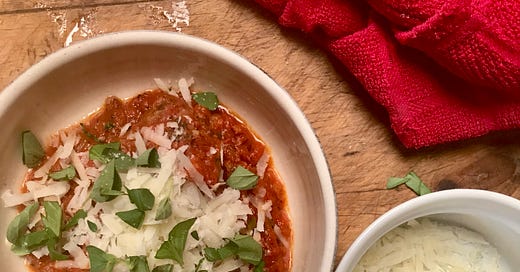Learning how to make a good pot of sauce is an essential life skill. I consider it equally as important as learning how to ride a bike without training wheels or tie your shoes for the first day of school.
Growing up, my mother made a pot of sauce every week. She’d creatively use the sauce to make a variety of recipes - spaghetti, lasagna, manicotti, meatballs, ravioli, rigatoni, etc. - all of which were fantastic especially after a boring day of school.
When I tell my wife about the foods I grew up eating, she finds it hard to believe that my mother actually made things like manicotti, homemade cannolis and stuffed shells. When you grow up eating tofu and peanut butter sandwiches anything else must sound like a fairy tale.
But, it wasn’t a fairy tale. It was what my mother actually made. And, she made home cooked meals for us each night, mostly Italian, because she loved to, because it made her feel connected to family and her heritage and because it was the most affordable way to feed 3 ravenous children.
My wife really lost it when I told her about my mother’s cream puffs and how she’d make them from scratch for my sister’s French class for their annual Bring a French inspired food to school day. I’m certain the other students brought stale crusted Wonder bread and Velveeta cheese - something my mother would never allow.
Like my mother’s sauce, my Traditional Italian Sauce recipe brings diversity, flavor and ear-to-ear smiles to those who eat it. If you’re wondering what you can do with a pot of sauce - especially if you eat a grain-free diet like myself - here are a handful of the many diverse and creative options to choose from:
Eggplant parm, chicken parm, veal parm, pasta (there are grain-free pasta options but I’ve found these to resemble the texture and flavor of old chewing gum), fried eggs, scrambled eggs, bread (Simple Mills offers a decent grain-free bread mix), meatballs and white fish, to name a few.
In addition to diversity points, sauce also requires very few ingredients, only a small window of your time to prepare (about 15 minutes) and, depending on how many mouths you’re feeding, can last throughout the week. It also freezes really well.
Once you’ve tried my sauce recipe and can make it in your sleep, please teach others how to make it. Traditional recipes are often locked away in the memories of the deceased—never to be accessed again. Or, they get lost in memorabilia stuffed away in dust covered cardboard boxes along with with childhood dolls, high school photos and old Christmas cards that all too often end up at the Salvation Army or the trash.
I also think marriages and families would be a lot healthier, a lot happier and meals a whole lot tastier if the couple took vows to learn how to cook certain foods when they tied the knot. In addition to, “Till death do us part” I think we need to add, “I vow to master meatballs, lamb chops, chocolate ice cream, ribeye steaks, Eggs Benedict and sauce” to keep the couple and family nourished and ancient food traditions alive.
Call me old fashioned or just give it a try and let me know how it goes. Nothing will win your spouse, kids or friends over more than a delicious home cooked meal. Especially a nourishing pot of sauce.
There are hundreds of different types of sauce in Italy alone. You have the Carbonara - a freaking delicious sauce made from egg yolks and pork jowls (cheeks) or bacon; you have Bolognese which simply means, meat sauce and can include quite literally any meat - beef, pork, rabbit, veal - you get the picture; you have a red sauce with anchovies which is exactly what it sounds like and you have what I call, a traditional sauce.
Of course, the list goes on and on.
Whether you choose to woo your partner with wine and meatballs, feed a throng of people eggplant parm or make an elegant Italian meal for yourself, my Traditional Italian Sauce recipe should more than suffice.
CHEF’S NOTE
Tomatoes are at the heart of this sauce. The gold standard would be to use fresh tomatoes that have been lightly stewed. The next best option would be to use tomatoes that you’ve canned or frozen from your garden. If those two options aren’t available then it’s time to explore store-bought tomato options, which are plentiful yet there are some considerations to take into account before simply placing a jar of tomatoes into your cart.
First, avoid buying canned tomatoes that have the ingredient, citric acid. Citric acid is often derived from GMO corn, especially in the States. Also avoid buying tomatoes in tin cans and instead look for tomatoes in a glass jar. Yes, these do exist and I have linked one of my favorite brands in the recipe for you.
I also recommend buying organic, whole, peeled tomatoes. However, if those aren’t available, get diced or crushed tomatoes.
You will be adding your own organic herbs to the sauce so there’s no need to buy canned tomatoes that have herbs added, such as basil. Look for organic canned tomatoes, in glass jars with the only ingredient being, tomatoes or tomatoes and sea salt.
My recommendations around tomato paste are similar. Tomato paste is an essential ingredient to my Traditional Italian Sauce as it thickens the sauce, adds robust flavor and natural sweetness. However, try to avoid tomato paste that contains citric acid or that is packaged in tin cans. Look for organic tomato paste in glass jars with the only ingredient being, tomato paste. I have also linked the brand I use in the recipe.
While you can prepare this sauce in about 15 minutes, especially once you have it down, you will let it cook for at least 30 minutes and up to 2 hours. This will be a set-it-and-forget-it type of sauce however please check in on it every so often as you would a newborn baby to be sure it doesn’t stick to the pot.
A note on herbs in your sauce…
I love an herb flavored sauce. This is why I add marjoram and fennel seeds to my sauce (I know, how Sicilian of me). These additions are my personal preference so please feel free to omit if you prefer a less herbaceous sauce.
Lastly, if you’re feeding more than 3 hungry mouths, double the recipe.
This recipe goes amazingly with a light or full bodied glass of biodynamic, organic wine or, I will admit, my wife enjoy’s a big glass of raw milk from our cow to accompany sauce night.
Buon Appetito,
Heathar
HEATHAR’S TRADITIONAL ITALIAN SAUCE RECIPE
1 quart or 28-32 ounces whole, crushed or diced tomatoes
7 ounces tomato paste (add more if you want a thicker sauce)
1/2 onion, diced
3-4 Tbsp lard, butter or extra virgin olive oil
4 cloves garlic, diced
1 Tbsp dried basil
1 Tbsp dried fennel (optional)
2 tsp dried oregano
2 tsp dried marjoram (optional, use if you want a more herb flavored sauce)
Sea salt and pepper (preferably fresh ground) to taste
DIRECTIONS
Chop onion and garlic.
Melt the fat in a medium size stainless steel pot. Add onion and garlic. Sauté for 1-2 minutes. Add the herbs, salt, pepper and fennel (if using). Sauté for another 1-2 minutes.
Add the tomatoes. If using whole tomatoes, gently break them up with a spatula. Sauté for about 1 minute.
Add the tomato paste. If your sauce gets too thick for your liking after adding the tomato paste, fill the tomato paste jar with water or bone broth and stir into the sauce.
Allow sauce to simmer for 3-5 minutes, uncovered. Reduce heat to lowest setting, cover and let cook for 30 minutes - 2 hours. Check your sauce periodically - you don’t want it to stick or burn! Stir as needed.
Once your sauce is done, use to make your favorite traditional Italian meals. This sauce is also amazing on scrambled or fried eggs - don’t forget to add grated pecorino to all of your sauce inspired meals.
Since I mention my mother so often (I must give credit when credit is due) I thought I’d introduce you to her. Meet my mother, Annette. 2nd generation Sicilian and the inspiration behind my love for traditional Italian food. Grazie, Mamma.
While Heathar is a chef and homesteader, she’s also a homeopathic practitioner. You can read about Heathar’s homeopathic practice and her Practitioner Training program, on her Study Homeopathy Substack.
If you’re interested in learning about Heathar’s farm, you can learn more, right here.
Please note, to support the publication of my cookbook, and to make your cooking experience a more nourishing and organic one, some of the links in this post are affiliate links.




